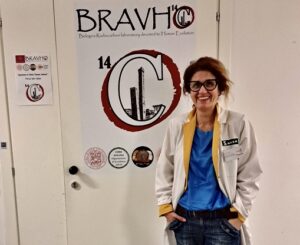
UNIVERSITÀ DI BOLOGNA—It is called Radiocarbon 3.0: it is the newest method developments in radiocarbon dating, and promises to reveal valuable new insights about key events in the earliest human history, starting with the interaction between Homo Sapiens and Neanderthals in Europe. This is shown by the combination of updated radiocarbon pretreatment, the latest AMS instrumental advances, and the application of the Bayesian model coupled with the new IntCal20, including the Kauri floating tree-ring section.
These important findings – published in the journal PLOS ONE – are the result of extensive research work, coordinated by Professor Sahra Talamo, director of the BRAVHO Radiocarbon Laboratory at the University of Bologna. Two international radiocarbon experts from the University of Heidelberg (Germany) and ETH Zurich (Switzerland) collaborated to the research as well as the isotope expert at Simon Fraser University (Canada).
The new publication presents an advanced evaluation and discussion of two earlier, widely recognized publications (Hublin et al. Nature 2020; Fewlass et al. Nature Eco&Evo 2020), focused on the earliest Homo Sapiens in Europe and their temporal relationship with Neanderthals. The crucial challenge is high temporal resolution chronology, which so far was severely limited by the low number of dates per site, low resolution of the Radiocarbon calibration curve, and limited Bayesian modelling.
In this new publication, these central aspects are addressed in a new, fully integrated way: (1) Only dates of samples pretreated in the state-of-the-art methodology are considered, (2) the most recent advances in the AMS Radiocarbon measurement technique are applied, and (3) Radiocarbon calibration is now based on a section of high-resolution Glacial tree-ring chronologies in the age range of 44,000 and 41,000 calendar years BP (Before 1950 AD).
The concise amalgamation of these three aspects, called Radiocarbon 3.0, leads to a new level of temporal interrelation between Homo Sapiens at the site of Bacho Kiro, Bulgaria, and, for the first time, a link between the respective presence of modern humans to climatic events (warm and cold phases) in the Glacial, documented in Greenland ice cores.
“Using Radiocarbon 3.0, we were able to reconstruct more accurately the movements of ancient hominids, which occurred at major European archaeological sites, during different climatic phases,” says Sahra Talamo, professor at the University of Bologna’s Department of Chemistry “Giacomo Ciamician” and first author of the study. “Thanks to this kind of analyses, it is therefore possible to obtain new valuable information on the evolution of the earliest human settlements and the resilience of hominids in different climatic phases, all of which may have contributed to the global spread of Homo Sapiens.”
Advertisement
Radiocarbon is the most widely applied dating method in archaeology, especially in studies of human evolution. In recent decades, it has enabled scholars around the world to make important advances in reconstructing the chronology of key events in our history. However, this method – based on the detection of a radioactive isotope of carbon, Carbon-14, in the organic samples studied – does not always allow us to obtain sufficiently precise and accurate dates to fully understand the important processes of human evolution, e.g., the interaction between Neanderthals and Homo Sapiens. The challenge was therefore to expand the capabilities of radiocarbon, increasing its high temporal resolution chronology.
Two new Bayesian models were constructed, using the direct dates of Homo Sapiens at Bacho Kiro, and Neanderthal dates of Vindija, Croatia, and Fonds-de-Foret, Belgium. Only the high-precision dates of Bach Kiro allow to assign the presence of Homo Sapiens at this site during the cold phase of GS 12 (Fig. 2 in the paper).
“In this study, we have shown that the human occupation at Bacho Kiro did not occur at once, but there were three different occupations (one around 44,650 to 44,430, one at 44,200 to 43,420 and one at 43110 to 42700 cal BP) or two different one (one around 44,650 to 44,430, one at 44,310 to 43,710 cal BP), depending on the 14C dates considered and the Bayesian model used,” explains Talamo.
At present, both scenarios could be supported because it is not yet known whether the Initial Upper Paleolithic may have lasted longer in Bacho Kiro than in the Levant or may have overlapped temporally with the Protoaurignacian dispersal.
“Moreover, obtaining a small 14C error in a time period around 42,000 years ago is a key point of radiocarbon 3.0,” explains Lukas Wacker, at the ETH Zurich and co-author of the paper. “The better this error interval is defined and obtained, the more accurate the final age calibration process will be”.
“In this paper, we have demonstrated the potential and advantages, both in terms of temporal and environmental accuracy, of discussing chronologies obtained from 14C ages with the same tight error intervals,” says Bernd Kromer at the University of Heidelberg (Germany) and co-author of the paper. “In addition, the extent of the Initial Upper Paleolithic (IUP) is constrained better by the new models, compared to the previous publications” (Fig. 3 in the paper).
“Our exercise shows that using radiocarbon 3.0 we are able to accomplish the definitive high resolution of European key archaeological sites during recurrent climate fluctuations, and model the human and faunal species’ responses from a diachronic perspective,” explains Michael Richards at Simon Fraser University (Canada) and co-author of the paper. “This is the way to promote knowledge exchange between archaeology, palaeoclimatology, geochronology, and geosciences in general, all essential disciplines in the study of the human past.”
The study was published in the journal PLOS ONE under the title “Back to the future: the advantage of studying key events in human evolution using a new high-resolution radiocarbon method.” It was carried out by an international research team, led by Prof. Sahra Talamo (University of Bologna), including Bernd Kromer (University of Heidelberg, Germany), Michael P. Richards (Simon Fraser University, Canada) and Lukas Wacker (ETH Zurich, Switzerland).
_________________________________

Professor Sahra Talamo, director of the BRAVHO Radiocarbon Laboratory at the University of Bologna and first author of the study. University of Bologna
_________________________________
Article Source: UNIVERSITÀ DI BOLOGNA news release
*Back to the future: the advantage of studying key events in human evolution using a new high resolution radiocarbon method, PLoS ONE, 15-Feb-2023. 10.1371/journal.pone.0280598
Advertisement
_________________________________

Don’t miss out on this unforgettable evening as Dr. Hawass reveals the most closely guarded secrets of ancient Egypt and presents his groundbreaking new discoveries and latest research live on stage. As the man behind all major discoveries in Egypt over the last few decades and director of several ongoing archaeological projects, Dr. Hawass may yet surprise you with unexpected revelations that will make news across the world.
_________________________________
Advertisement




